12/18/2013. Under the Moonlight, this serious moonlight, I aimed at IC 63 in Cassiopeia, a space oddity just a few light years from Gamma Cassiopeia, a star about 50,000 times brighter than the Sun. Gamma Cas's starlight is rich in UV which is eroding and shaping the wispy gas of IC 63. I last shot this area three years ago using the 5-inch refractor (look here). I remembered that the nebulosity appeared to be edged in hydrogen-alpha emission, so I thought it might be a good target in the moonlit night. I made a series of 1800s exposures through the Baader 7nm H-a filter with the detector cooled to -20°C. Because my darks at 1800s were shot at -30°C, I took a series of bias frames right after I shot Christmas tree flats; Maxim can use the bias data to adjust my darks accordingly. Worked well:
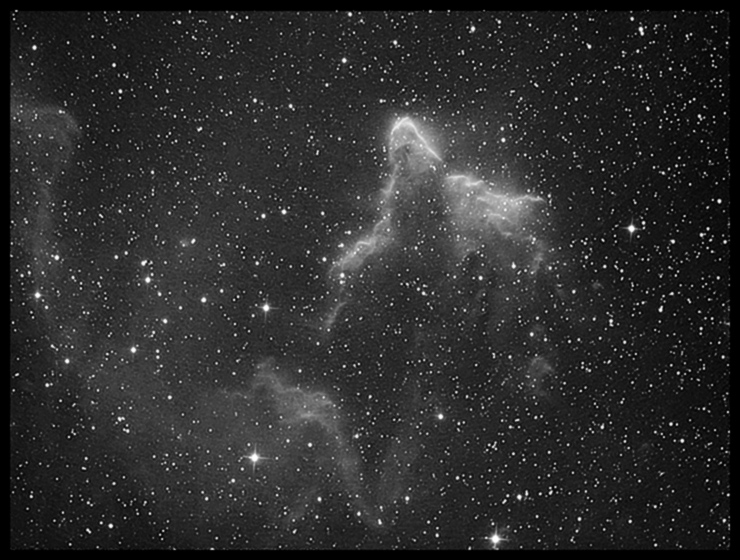
IC 63
AT10RC @ F4.8
10x1800s (5 hours)
Baader 7nm H-a filter
(focused with Bahtinov mask using L filter)
Why not just shoot at -30°C and be done? The camera has been having frost issues. I replaced the dessicant a few sessions ago; I replaced it again last night. I ran it all night and all day at various warm temperatures (just above and just below freezing) hoping the chamber would dry out. Late in the afternoon, I brought it inside, pulled the filters, did not crack the CCD chamber, and played a hair-dryer around the camera body for half an hour. My thought was that if I could lift the moisture into vapor, the dessicant would capture it. Helped but did not cure the ailment: the camera images cleanly down to -20°C, but frost fingers form whenever I try to go lower. If this persists, I'll try baking the whole camera at 40-50°C for several hours. The CCD is spending the rest of the night shooting -20°C darks.
12/18/2013. I still have frosting problems in the camera. While the CCD bakes, I put last night's fresh darks to work. And there's a real difference. Look how much smoother the finished image is! So, when at all possible, use darks at the right temperature rather than relying on Maxim and bias frames to force mismatched darks to serve:
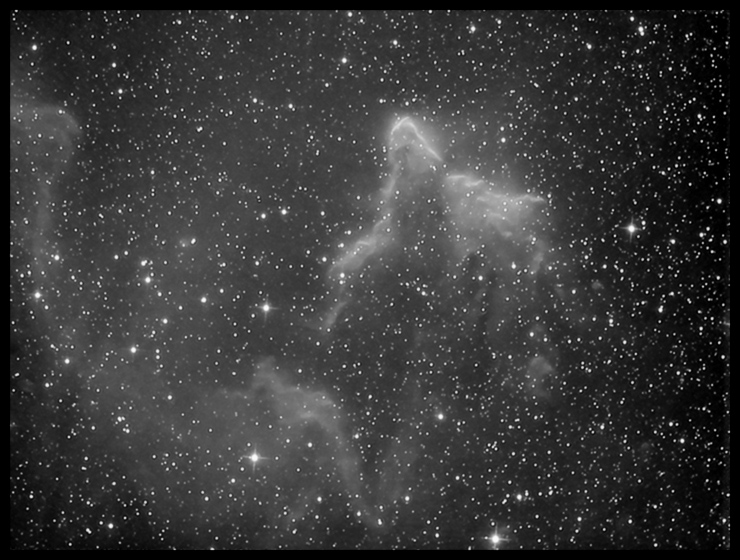
Same, except calibrated using 15 darks at -20°C
I brought the camera inside, removed the filter wheel, and set it on a baking sheet in a 110°F oven for 4.5 hours. When I tried it out, it still promptly frosted badly below -25°C. I applied some silicon lube to the O-rings in the Particle Wave desiccant holder and used yet another desiccant pack. I am down to three. I Googled by brand name (MiniPax Sorbent, "Pillow Pak"), type (molecular sieve), and size (3 grams) without notable success. Particle Wave Technologies stopped offering this refillable dessicant option some years back, but I discovered that Farpoint now offers the same system under its name. Googling "SBIG desiccant refill" turns up some sources for small quantities (I don't need a ton from China or a 5 gallon pail from India --at least I hope I don't). You can buy the refills ten at a time from Amazon (fulfilled by Adorama), or from Farpoint, or from Gary Hand (Hands on Optics, in Maryland). About a buck apiece in packs of ten. Gary covers shipping, and I'd rather deal with an individual, so I sent him $20 for enough refills to get this thing squared away. I'll stash some in the RV for future needs. For now, the CCD is sealed in a Pelican case along with a 40g silica gel cannister. It may be a few days until the sky is clear again. By then...
12/25/2013. Last night was a sparkler, but it was also Christmas Eve and it did not seem exemplary of domestic considerations to spend it cussing a CCD and otherwise engaging in astronomical adventure. I nevertheless stole a few minutes to find and document the best focus positions of my two fast and wide manual focus primes. In each case, the best focus was readily nailed by using live view on the planet Jupiter. Assuming that I won't always have such an obliging target and a heavy tripod at hand, it's worth noting the positions:
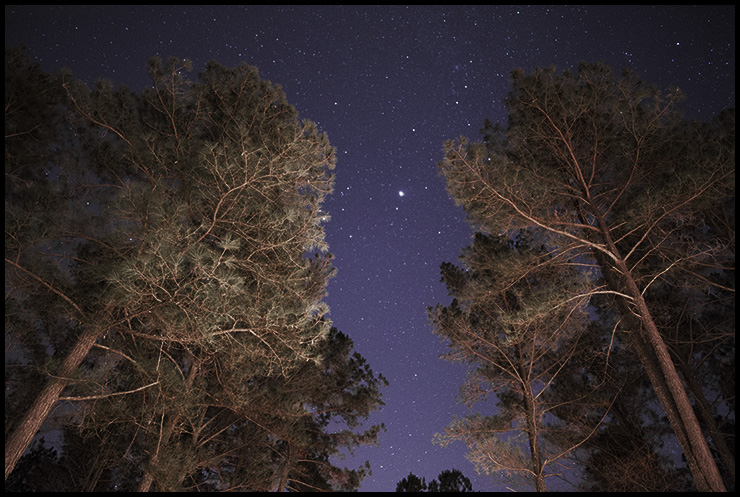
24mm Rokinon. 2 seconds at F1.4, 12800 ISO
with the focus ring set thus (ignore the aperture ring in this photo):
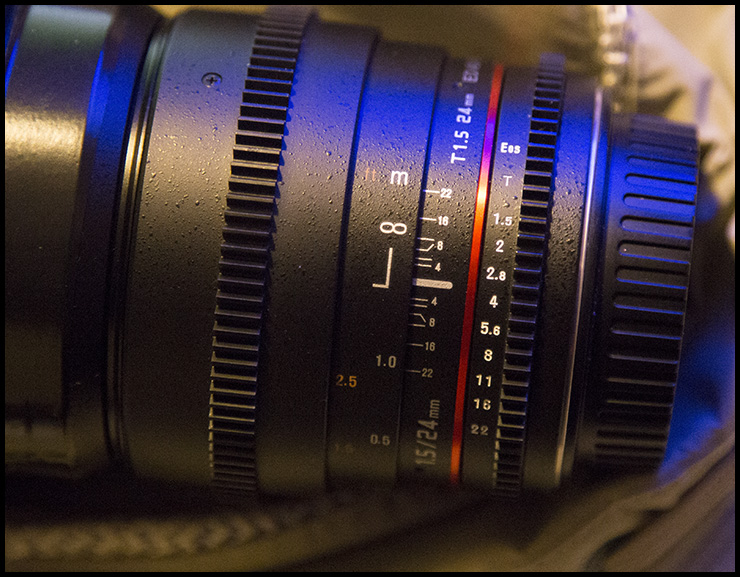
infinity focus for the 24mm F1.4 Rokinon (cinema version)
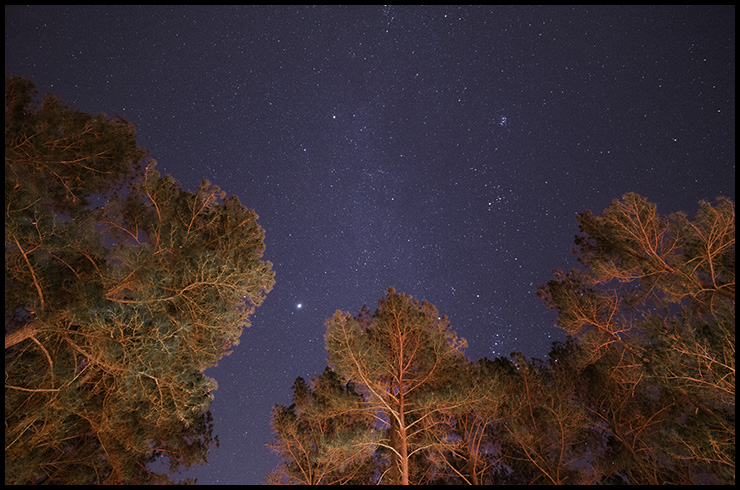
14mm Rokinon. 8 seconds at F2.8, 12800 ISO
with the lens set like this:
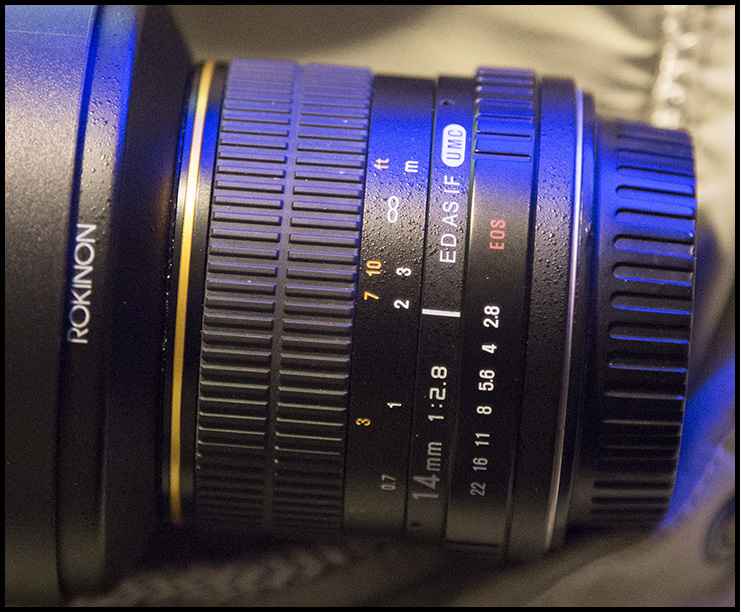
infinity focus for the 14mm F2.8 Rokinon
And for the record, the CCD on Christmas day still shows frost growing out from two nuclei that appear to be on the chip itself (I installed one of the new desiccant packs over a day ago). I'm thinking hard about how to attack this. In the meantime, I'll image with the chip cooled to a moderate -20°C or warmer.
Tonight is much clearer than the forecast led me to expect. I collected color data for IC 63 early in the evening and had the telescope add to the hydrogen-alpha pile as long as the sky stayed clear. At half an hour till midnight, the sky is still good, so this is a work in progress. If another hour or two of good data comes in, I'll add it. In any case, I am sure that even a little time with PixInsight can improve this quick look. One way or another, the image below is sure to be replaced, but here's what I have so far:
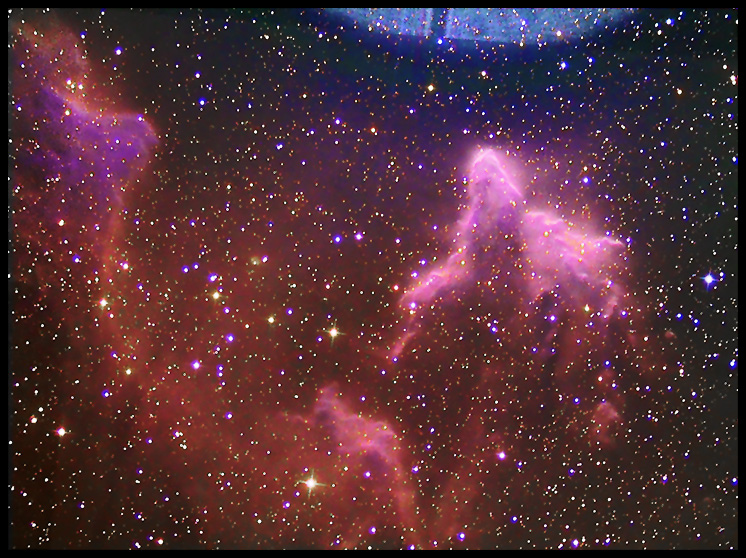
IC 63 (with glare of Gamma Cas at top)
15x1800s (7.5 hours) H-a + 10x150s (1h15m total) RGB
Here you go. A little more exposure combined with the color data from earlier in the evening helps. But the real difference is handling the pile of data largely in PixInsight, a specialized package for astronomical image processing rather than cobbling it all up using general-purpose software. The good stuff produces a more "measured" image, cleaner, more more. The difference is visible here on the web; it's striking in the larger 16-bit files.

IC 63 (with glare of Gamma Cas at top)
20x1800s (10 hours) H-a + 10x150s (1h15m total) RGB
An hour and a half after midnight, Cassiopeia moved too low in the western sky to continue, but the sky remained clear. I slewed the telescope to the vicinity to AE Aurigae, a variable star north of Orion moving through a compex field of interstellar dust and gas. I hit the sack and left the telescope to its business. Increasing haze and the western motion of the sky ended useful data collection after two hours. It's a good start:
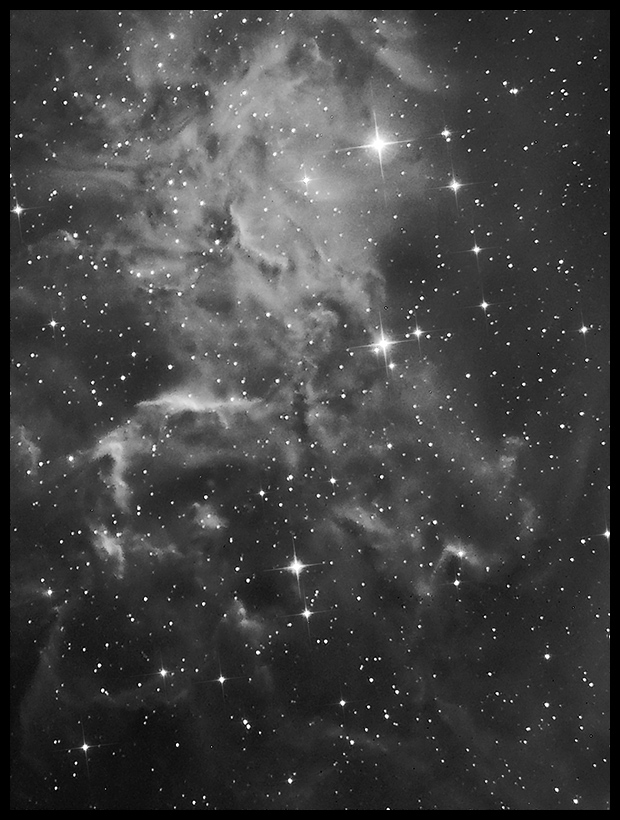
AE Aurigae (brightest star in the photo) and the "Flaming Star" Nebula, IC 405
4x1800s (2 hours), Baader 7nm H-a filter
Interesting star this one. It and two others are "runaway stars." AE Aurigae's 3D space motion (upwards of 120 km/sec) suggests an origin in the bright star forming region in the sword of Orion (present day M42 and the Trapezium). There's a good case to be made that it was expelled during close encounters with other stars about two million years ago. You book along at 80 miles per second for two million years and you go places. At the moment, it's passing through this cloud of hydrogen, exciting some of it to glow at the hydrogen-alpha wavelength and lighting up some by reflected starlight — of which it has plenty since AE Aurigae shines with the light of about 30,000 suns. The distinction between excited and reflected light will become plain when I add RGB data during the next clear spell.
Except where noted, deep-sky photos are made with an SBIG ST2000XM CCD behind a 10-inch Astro-Tech Ritchey-Chretien carried on an Astro-Physics Mach1GTO. The CCD is equipped with Baader LRGB and 7nm H-a filters. The internal guide chip of the CCD most often keeps the OTA pointed in the right direction (I'll let you know when a Meade DSI and a separate OAG or guidescope takes its place). Camera control and guiding are handled by Maxim DL 5.12. The stock focuser on the AT10RC has been augmented with Robofocus 3.0.9 using adapters turned on the lathe downstairs. Maxim performs image calibration, alignment, and stacking; Photoshop CS4 and FocusMagic 3.0.2 take it from there. Gradient Xterminator by Russell Croman and Astronomy Tools by Noel Carboni see their share of work, too. Beginning in May 2013, PixInsight has taken over some of the heavy lifting for transfer function modification and deconvolution.
:: top ::